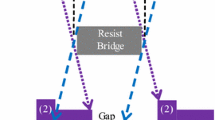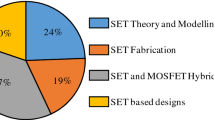Abstract
Due to their unique properties of ultralow power dissipation and extremely high density, single-electron devices represent the best option for highly sensitive sensors. Despite their excellent performance in capturing subtle electrical signals at cryogenic temperatures, the signal detectability at room temperature or higher is substantially degraded by thermal noise. To reduce such interference from thermal noise at room temperature, the physical dimensions of single-electron devices are conventionally scaled down to below 10 nm, but this leads to great challenges in device fabrication processes. The challenge of retaining superior signal detectability of single-electron devices at room temperature without aggressive scaling is addressed herein. It is proposed that the effects of capacitive and resistive signal coupling between adjacent single-electron devices can be exploited to enhance the signal-to-noise ratio of sensor outputs. A series of efficient coupled networks that shift the peak signal detectability from cryogenic to room temperature are studied. The impacts of the network topology, coupling strength, and bias voltage are investigated. The simulation results reveal that, for given device dimensions, the proposed coupled device network improves the room-temperature signal detectability by 13.2 dB (i.e., an enhancement of 200%) over the uncoupled device array. Moreover, at room temperature, the signal-to-noise ratio of the proposed nonscaled coupled device network is much better than that of aggressively scaled device arrays. These results confirm that efficient coupled networks enable the operation of supersensitive single-electron device sensors at room temperature.














Similar content being viewed by others
References
Averin, D.V., Likharev, K.K.: Coulomb blockade of single-electron tunneling. J. Low Temp. Phys. 62(3), 346–373 (1986)
Likharev, K.K.: Single-electron devices and their applications. Proc. IEEE 87, 606–632 (1999)
Ohshima, T., Kiehl, R.A.: Operation of bistable phase-locked single-electron tunneling logic elements. J. Appl. Phys. 80, 912–923 (1996)
Wei, Y., Weis, J., Klitzing, K., Eberl, K.: Single-electron transistor as an electrometer measuring chemical potential variations. Appl. Phys. Lett. 71, 2514–2516 (1997)
Nishiguchi, K., Koechlin, C., Ono, Y., Fujiwara, A., Inokawa, H., Yamaguchi, H.: Single-electron-resolution electrometer based on field-effect transistor. Jpn. J. Appl. Phys. 47, 8305–8310 (2008)
Kumar, O., Kaur, M.: Single electron transistor: applications and problems. Int. J. VLSI Des. Commun. Syst. 1(4), 24–29 (2010)
Nakamura, S., Pashkin, Y.A., Tsai, J., Kaneko, N.: Single-electron pumping by parallel SINIS turnstiles for quantum current standard. IEEE Trans. Instrum. Meas. 64(6), 1696–1701 (2015)
Karre, P., Acharya, M., Kundsen, W.: Single electron transistor-based gas sensing with tungsten nanoparticles at room temperature. IEEE Sens. J. 8, 797–802 (2010)
Beaumont, A., Dubuc, C., Beauvais, J., Drouin, D.: Room temperature single-electron transistor featuring gate-enhanced ON-state current. IEEE Electron Device Lett. 30(7), 766–768 (2009)
Deshpande, V., Wacquez, R., Vinet, M., Jehl, X.: 300 K operating full-CMOS integrated single electron transistor (SET)-FET circuits. In: Electron Devices Meeting, pp. 8.7.1-8.7.4 (2012)
Sun, Y., Singh, N.: Room-temperature operation of silicon single-electron transistor fabricated using optical lithography. IEEE Trans. Nanotechnol. 10(1), 96–98 (2011)
Zheng, H., Asbahi, M., Mukherjee, S., et al.: Room temperature Coulomb blockade effects in Au nanocluster/pentacene single electron transistors. Nanotechnology 26(35), 355204–355221 (2015)
Karbasian, G., McConnell, M.S., George, H.: Metal-insulator-metal single electron transistors with tunnel barriers prepared by atomic layer deposition. Appl. Sci. 7, 246–268 (2017)
Lu, C., Raghunathan, V., Roy, K.: Efficient design of micro-scale energy harvesting systems. IEEE J. Emerg. Sel. Top. Circuits Syst. 1(3), 254–266 (2011)
Utagawa, A., Asai, T.: Noise-driven image processing based on array-enhanced stochastic resonance with population heterogeneity. In: International Symposium on Intelligent Signal Processing and Communication Systems, pp. 437–440 (2009)
Querlioz, D., Trauchessec, V.: Stochastic resonance in an analog current-mode neuromorphic circuit. In: IEEE International Symposium on Circuits and Systems, pp. 1596–1599 (2013)
Imai, Y., et al.: Detection of weak biological signal utilizing stochastic resonance in a GaAs-based nanowire FET and its parallel summing network. Jpn. J. Appl. Phys. 53(6S), 06JE01 (2014)
McNamara, B., Wiesenfeld, K.: Theory of stochastic resonance. Phys. Rev. A 39, 4854–4869 (1989)
Maass, W.: Noise as a resource for computation and learning in networks of spiking neurons. Proc. IEEE 102(5), 860–880 (2014)
Oya, T., Asai, T., Amemiya, Y.: Stochastic resonance in an ensemble of single-electron neuromorphic devices and its application to competitive neural networks. Chaos Solitons Fractals 32(2), 855–861 (2007)
Kasai, S.: Stochastic resonance in nanodevice parallel systems. In: International Symposium on Intelligent Signal Processing and Communication Systems, pp. 363–366 (2009)
Sato, S., Nakajima, K.: Application of single electron devices utilizing stochastic dynamics. Int. J. Nanotechnol. Mol. Comput. 1(2), 29–42 (2009)
Oya, T.: Stochastic resonance in a balanced pair of single-electron boxes. Fluct. Noise Lett. 10(3), 267–275 (2011)
Weber, J., Weis, J., Hauser, M., Klitzing, K.: Fabrication of an array of single-electron transistors for a scanning probe microscope sensor. Nanotechnology 19(37), 375301 (2008)
Korotkov, A.: Single-electron transistor controlled with a RC circuit. Phys. Rev. B 49(23), 518–522 (1994)
Oya, T., Takahashi, Y., Ikebe, M., Asai, T., Amemiya, Y.: A single-electron circuit as a discrete dynamical system. Superlattices Microstruct. 34, 253–258 (2003)
Oya, T., Asai, T., Fukui, T., Amemiya, Y.: Reaction–diffusion systems consisting of single-electron oscillators. Int. J. Unconv. Comput. 1, 177–194 (2005)
Guo, D., Wu, S., Sbitnev, V.I., Chua, L.O.: Stochastic resonance of SET device implemented for nanoscale sensor operating in room temperature. In: Proceedings of Pacific Rim Workshop on Transducers and Micro/Nano, pp. 425–428 (2002)
Fujino, H., Oya, T.: Analysis of electron transfer among quantum dots in two-dimensional quantum dot network. Jpn. J. Appl. Phys. 53(6S), 06JE02 (2014)
Babiker, S.F., Naeem, R.: Shot noise suppression in single electron transistors. IEEE Trans. Nanotechnol. 11(6), 1267–1272 (2012)
Martinez, C., Beivide, R., Stafford, E., Moreto, M., Gabidulin, E.M.: Modeling toroidal networks with the Gaussian integers. IEEE Trans. Comput. 57, 1046–1056 (2008)
Wu, Y., Zhao, J., Chen, D., Guo, D.: Modeling of Gaussian network-based reconfigurable network-on-chip designs. IEEE Trans. Comput. 65, 2134–2142 (2016)
Author information
Authors and Affiliations
Corresponding authors
Additional information
Publisher's Note
Springer Nature remains neutral with regard to jurisdictional claims in published maps and institutional affiliations.
Rights and permissions
About this article
Cite this article
Wu, Y., Zhao, R., Lu, C. et al. Modeling of single-electron tunneling networks for supersensitive sensors at room temperature. J Comput Electron 19, 222–233 (2020). https://doi.org/10.1007/s10825-019-01436-x
Published:
Issue Date:
DOI: https://doi.org/10.1007/s10825-019-01436-x




